登録情報 データベース : EMDB / ID : EMD-46571タイトル CryoEM structure of PAR1 with endogenous tethered ligand 複合体 : Complex of PAR1 with G proteinsタンパク質・ペプチド : Proteinase-activated receptor 1タンパク質・ペプチド : Guanine nucleotide-binding protein G(I)/G(S)/G(T) subunit beta-1タンパク質・ペプチド : Guanine nucleotide-binding protein G(I)/G(S)/G(O) subunit gamma-2タンパク質・ペプチド : scFv16タンパク質・ペプチド : Guanine nucleotide-binding protein G(q) subunit alpha chimera / / 機能・相同性 分子機能 ドメイン・相同性 構成要素
/ / / / / / / / / / / / / / / / / / / / / / / / / / / / / / / / / / / / / / / / / / / / / / / / / / / / / / / / / / / / / / / / / / / / / / / / / / / / / / / / / / / / / / / / / / / / / / / / / / / / / / / / / / / / / / / / / / / / / / / / / / / / / / / / / / / / / / / / / / / / / / / / 生物種 Homo sapiens (ヒト) / Mus musculus (ハツカネズミ)手法 / / 解像度 : 2.74 Å Lyu X / Lyu Z / McGrath AP / Kang Y 資金援助 1件 Organization Grant number 国 Not funded
ジャーナル : Nat Commun / 年 : 2025タイトル : Structural basis for the activation of proteinase-activated receptors PAR1 and PAR2.著者 : Zongyang Lyu / Xiaoxuan Lyu / Andrey G Malyutin / Guliang Xia / Daniel Carney / Vinicius M Alves / Matthew Falk / Nidhi Arora / Hua Zou / Aaron P McGrath / Yanyong Kang / 要旨 : Members of the proteinase-activated receptor (PAR) subfamily of G protein-coupled receptors (GPCRs) play critical roles in processes like hemostasis, thrombosis, development, wound healing, ... Members of the proteinase-activated receptor (PAR) subfamily of G protein-coupled receptors (GPCRs) play critical roles in processes like hemostasis, thrombosis, development, wound healing, inflammation, and cancer progression. Comprising PAR1-PAR4, these receptors are specifically activated by protease cleavage at their extracellular amino terminus, revealing a 'tethered ligand' that self-activates the receptor. This triggers complex intracellular signaling via G proteins and beta-arrestins, linking external protease signals to cellular functions. To date, direct structural visualization of these ligand-receptor complexes has been limited. Here, we present structural snapshots of activated PAR1 and PAR2 bound to their endogenous tethered ligands, revealing a shallow and constricted orthosteric binding pocket. Comparisons with antagonist-bound structures show minimal conformational changes in the TM6 helix and larger movements of TM7 upon activation. These findings reveal a common activation mechanism for PAR1 and PAR2, highlighting critical residues involved in ligand recognition. Additionally, the structure of PAR2 bound to a pathway selective antagonist, GB88, demonstrates how potent orthosteric engagement can be achieved by a small molecule mimicking the endogenous tethered ligand's interactions. 履歴 登録 2024年8月13日 - ヘッダ(付随情報) 公開 2025年5月7日 - マップ公開 2025年5月7日 - 更新 2025年5月14日 - 現状 2025年5月14日 処理サイト : RCSB / 状態 : 公開
すべて表示 表示を減らす
 データを開く
データを開く 基本情報
基本情報
 マップデータ
マップデータ 試料
試料 キーワード
キーワード 機能・相同性情報
機能・相同性情報 Homo sapiens (ヒト) /
Homo sapiens (ヒト) / 
 データ登録者
データ登録者 引用
引用 ジャーナル: Nat Commun / 年: 2025
ジャーナル: Nat Commun / 年: 2025
 構造の表示
構造の表示 ダウンロードとリンク
ダウンロードとリンク emd_46571.map.gz
emd_46571.map.gz EMDBマップデータ形式
EMDBマップデータ形式 emd-46571-v30.xml
emd-46571-v30.xml emd-46571.xml
emd-46571.xml EMDBヘッダ
EMDBヘッダ emd_46571_fsc.xml
emd_46571_fsc.xml FSCデータファイル
FSCデータファイル emd_46571.png
emd_46571.png emd-46571.cif.gz
emd-46571.cif.gz emd_46571_half_map_1.map.gz
emd_46571_half_map_1.map.gz emd_46571_half_map_2.map.gz
emd_46571_half_map_2.map.gz http://ftp.pdbj.org/pub/emdb/structures/EMD-46571
http://ftp.pdbj.org/pub/emdb/structures/EMD-46571 ftp://ftp.pdbj.org/pub/emdb/structures/EMD-46571
ftp://ftp.pdbj.org/pub/emdb/structures/EMD-46571 emd_46571_validation.pdf.gz
emd_46571_validation.pdf.gz EMDB検証レポート
EMDB検証レポート emd_46571_full_validation.pdf.gz
emd_46571_full_validation.pdf.gz emd_46571_validation.xml.gz
emd_46571_validation.xml.gz emd_46571_validation.cif.gz
emd_46571_validation.cif.gz https://ftp.pdbj.org/pub/emdb/validation_reports/EMD-46571
https://ftp.pdbj.org/pub/emdb/validation_reports/EMD-46571 ftp://ftp.pdbj.org/pub/emdb/validation_reports/EMD-46571
ftp://ftp.pdbj.org/pub/emdb/validation_reports/EMD-46571 リンク
リンク EMDB (EBI/PDBe) /
EMDB (EBI/PDBe) /  EMDataResource
EMDataResource マップ
マップ ダウンロード / ファイル: emd_46571.map.gz / 形式: CCP4 / 大きさ: 52.7 MB / タイプ: IMAGE STORED AS FLOATING POINT NUMBER (4 BYTES)
ダウンロード / ファイル: emd_46571.map.gz / 形式: CCP4 / 大きさ: 52.7 MB / タイプ: IMAGE STORED AS FLOATING POINT NUMBER (4 BYTES) 試料の構成要素
試料の構成要素 Homo sapiens (ヒト)
Homo sapiens (ヒト) Homo sapiens (ヒト)
Homo sapiens (ヒト)
 Homo sapiens (ヒト)
Homo sapiens (ヒト)
 Homo sapiens (ヒト)
Homo sapiens (ヒト)


 Homo sapiens (ヒト)
Homo sapiens (ヒト)
 解析
解析 試料調製
試料調製 電子顕微鏡法
電子顕微鏡法 FIELD EMISSION GUN
FIELD EMISSION GUN ムービー
ムービー コントローラー
コントローラー




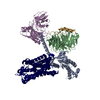


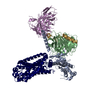
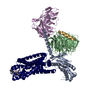
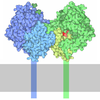


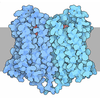
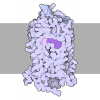













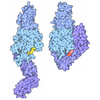

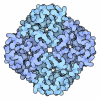
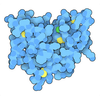




 Z (Sec.)
Z (Sec.) Y (Row.)
Y (Row.) X (Col.)
X (Col.)





































